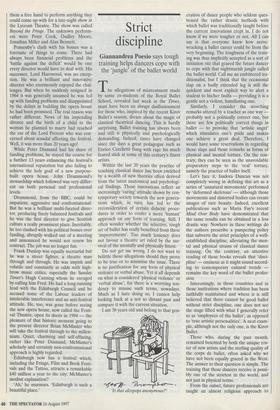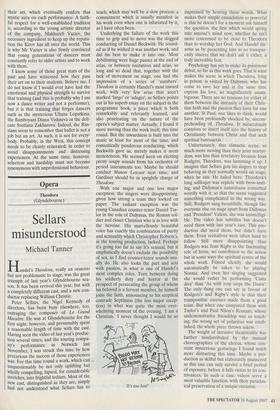Strict discipline
Giannandrea Poesio says tough training helps dancers cope with the 'jungle' of the ballet world The allegations of mistreatment made by some ex-students of the Royal Ballet School, revealed last week in the Times, must have been an abrupt disillusionment for those who, inspired by the recent Kirov Ballet's season, dream about the magic of classical theatrical dancing. This is hardly surprising. Ballet training has always been and still is physically and psychologically demanding. Indeed, times have changed since the days a great pedagogue such as Enrico Cecchetti flung with rage his much feared stick at some of this century's finest artists.
Within the last 20 years the practice of teaching classical dance has been enriched by a wealth of new theories often derived from the latest anatomical and psychologi- cal findings. These innovations reflect an increasingly 'caring' attitude shown by con- temporary society towards the new genera- tions which, in turn, has led to the reconsideration of certain didactic proce- dures in order to confer a more 'human' approach on any form of learning. Still, I often wonder whether the selective, tough art of ballet has really benefited from these `improvements'. Too much leniency does not favour a theatre art ruled by the sur- vival of the mentally and physically fittest.
Do not get me wrong. I do not want to belittle those allegations should they prove to be true or to minimise the issue. There is no justification for any form of physical violence or verbal abuse. Yet it all depends on what is considered 'physical violence' or `verbal abuse', for there is a worrying ten- dency to misuse such terms, nowadays. Much as I hate doing so, I cannot help looking back at a not so distant past and compare it with the current situation.
I am 38 years old and belong to that gen-
Is that alcopops anonymous?'
eration of dance people who seldom ques- tioned the rather drastic methods with which ballet was traditionally taught before the current innovations crept in. I do not know if we were tougher or not. All I can say is that everyone knew how nerve- wracking a ballet career could be from the very beginning. The toughness of the train- ing was thus implicitly accepted as a sort of initiation rite that geared the future dancer to cope with that nightmarish jungle called the ballet world. Call me an embittered tra- ditionalist, but I think that the occasional slap on a badly extended leg is still the quickest and most explicit way to alert a student to his/her faults — providing it is a gentle not a violent, humiliating one.
Similarly, I consider the scorching remarks uttered by a teacher as one way probably not a politically correct one, but there are few politically correct things in ballet — to provoke that 'artistic anger' which stimulates one's pride and makes one achieve a great deal. Therefore, I would have some reservations in regarding those slaps and those remarks as forms of physical and mental torture. On the con- trary, they can be seen as the unavoidable preparatory steps to the `real' torture, namely the practice of ballet itself.
Let's face it, Isadora Duncan was not completely wrong in defining this art as a series of 'unnatural movements' performed by 'deformed skeletons' — although those movements and distorted bodies can create images of rare beauty. Indeed, excellent publications such as Maria Fay's recent Mind Over Body have demonstrated that the same results can be obtained in a less drastic way. Nowhere in these writings do the authors prescribe a pampering policy that subverts the strict principles of a well- established discipline, alleviating the men- tal and physical strains of classical dance training. On the contrary, an attentive reading of these books reveals that 'disci- pline' — ominous as it might sound accord- ing to contemporary cultural trends remains the key word of the ballet profes- sion.
Interestingly, in those countries and in those institutions where tradition has been faithfully maintained and where it is still believed that there cannot be good ballet without strict discipline, one does not see the stage filled with what I generally refer to as 'employees of the ballet', as opposed to 'true artistic personalities'. A neat exam- ple, although not the only one, is the Kirov Ballet.
Those who, during the past month, remained besotted by both the unique ros- ter of new artists and the sterling quality of the corps de ballet, often asked why we have not been equally graced in the West. The answer to their question is simple. The training that those dancers receive is possi- bly one of the strictest in the world, and not just in physical terms.
From the outset, future professionals are taught an almost religious approach to their art, which eventually confers that mystic aura on each performance. A faith- ful respect for a well-established tradition is, according to the young artistic director of the company, Makhareb Vaziev, the necessary ingredient to keep up the reputa- tion the Kirov has all over the world. This is why Mr Vaziev is also firmly convinced that young generations of dancers must constantly refer to older artists and to work with them.
I know some of those great stars of the past and have witnessed how they pass their art on to their students. Believe me, I do not know if I would ever have had the emotional and physical strength to survive that training (and this is probably why I am now a dance writer and not a performer), but it is that training that forges dancers such as the mysterious Uliana Lopatkina, the flamboyant Diana Vishneva or the deli- cate Svetlana Zakharova. Indeed, the Rus- sians seem to remember that ballet is not a job but an art. As such, it is not for every- body. Probably, in the West, this concept needs to be clearly reiterated, in order to avoid disappointments and distressing experiences. At the same time, however, selection and hardship must not become synonymous with unprofessional behaviour.



























































 Previous page
Previous page